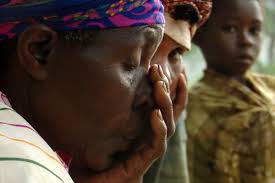Thursday, March
 |
| Kasese Massacre 2016 – Image may be subject to copyright |
CHANGE OF GUARDS – On March 6th, Museveni’s regime owned New Vision broke the news of an an attack on the Museveni army that had taken place on the night of Thursday March 5, 2020. It disclosed that an unknown group of about 200 attackers armed with guns, spears, machetes and other traditional weapons had raided a Museveni army detachment in Oduk Village, Zombo Town Council, Zombo District in Nebbi sub-region. It further reported that the attack left five soldiers dead and 22 attackers killed while 35 of the so-called invaders were “captured in the immediate and subsequent clashes as the UPDF repulsed the insurgents.” The paper quoted the army Spokesman, Brig. Karemire who described the attack as “suicidal.” The army Spokesman for the West Nile region, Maj. Kavuma was also quoted as confirming that the attack had been “repulsed and the situation was back to normal.” The bodies of the dead attackers were tightly guarded at the Paidha Health Centre III while the identities of the soldiers who were killed remains a top secret.
Since the incident took place almost a week ago, the regime has not come out to issue a formal statement. Instead, it’s a few media houses that have endeavoured to bring out bits of updates over the incident. Consequently, for sinister motives, the different regime agencies are clashing over what information to avail to the public. After a closed door meeting attended by all the regional security managers, on March 8, the RDC who is the Chairman of the District Security Committee told the media that the attack was carried out by a new rebel group called Uganda Homeland Liberation Force (UHLF). Citing intelligence sources, the same RDC gave the motive, the ethnic composition, the leadership and mode of recruitment and the place where the attackers were trained.
Interestingly, the army has come out to vehemently rubbish the RDC’s statement. The army’s 4th Division Spokesman said;
“Where did the RDC get his information? He has not been part of the investigations because we are the ones holding some of the captives who are yet to tell us who they are exactly. I appeal to leaders to desist from making unconfirmed statements without verifying with us. He has not been at the front-line. These are just a gang of criminals and although they can be dangerous because they also had some guns. We are not sure of that information from the RDC unless some of the captives are in his custody. We have not yet finished our investigations to make such conclusions. What we know is that these are a cult-like group. The situation is now normal.”
Later on, a statement by the army’s Deputy Spokesman reduced the number of attackers to around 80 and claimed that they had no guns. The statement further claimed that the attackers had been “misled by some Congolese elements seeking guns for use for criminal activities in Eastern Congo.” The statement went further to claim that it’s three soldiers who had been killed in the attack by assailants it claimed “were mobilised by some group who were recently given amnesty by government including one Ovoya, a witch doctor and other ring leaders like Atochon, Oketcha, Openji Openjuru and a UPDF veteran Coporal Tonifa Bosco.”
The same statement went ahead to put the figure of the attackers who were killed to 17 and 26 captured with the help of the locals. The same statement said the army was coordinating with their counterparts in DRC to track those that fled there. It went ahead to dismiss the March 9th report by the regime owned New Vision which had quoted the RDC’s claims that the said assailants had been trained in Kiryandongo.
Around late 2016, a similar incident in the Rwenzori region left a number of security personnel dead while the army massacred more than 100 locals and brutally rounded up other hundreds who remain incarcerated todate. The incident attracted wide condemnation throughout the world and is part of the grounds for the ongoing petition before the ICC over Museveni’s war crimes. The Museveni regime claimed that the victims of the Rwenzori Massacre were rebels who had links to some groups from DRC. Fortunately, the Rwenzori Massacre was effectively covered by the media thus minimizing the carnage by exposing the actions of the perpetrators. In the current carnage in Nebbi, Museveni’s security forces are using the 2016 lessons from Rwenzori to contain the flow of information.
Just like the one of Rwenzori, this one is also linked to groups in DRC only that the army is trying to downplay its political connotation. The alleged leader of rebel UHLF, Mr. Openjuru is said to have disassociated his group from the attack but at the same time went ahead to confirm the existence of his group which he said will at the right time liberate Uganda. Obviously, like had been the case in Rwenzori, the security forces must be brutally rounding up, torturing and even killing innocent locals. Unfortunately, there is a conspiracy of silence from all corners as to what is transpiring in Zombo. Neither parliament nor civil society is bothered with what is going on. What is obvious, is that when the carnage comes to light, the world will be shocked by the gross abuse and crimes against humanity that will have been committed by Museveni’s army in Zombo.
What is at stake is:
WHY WOULD CIVILIANS REPEATEDLY TAKE THE RISK OF ATTACKING A REGIME MILITARY CAMP???
INFORMATION IS POWER AND THE PROBLEM OF UGANDA IS MUSEVENISM
About Author
Owoyesigire Medard
Business, Special News, and Feature Story Writer. He is a Professional ICT Consultant, Website Developer, and Graphic Designer.


